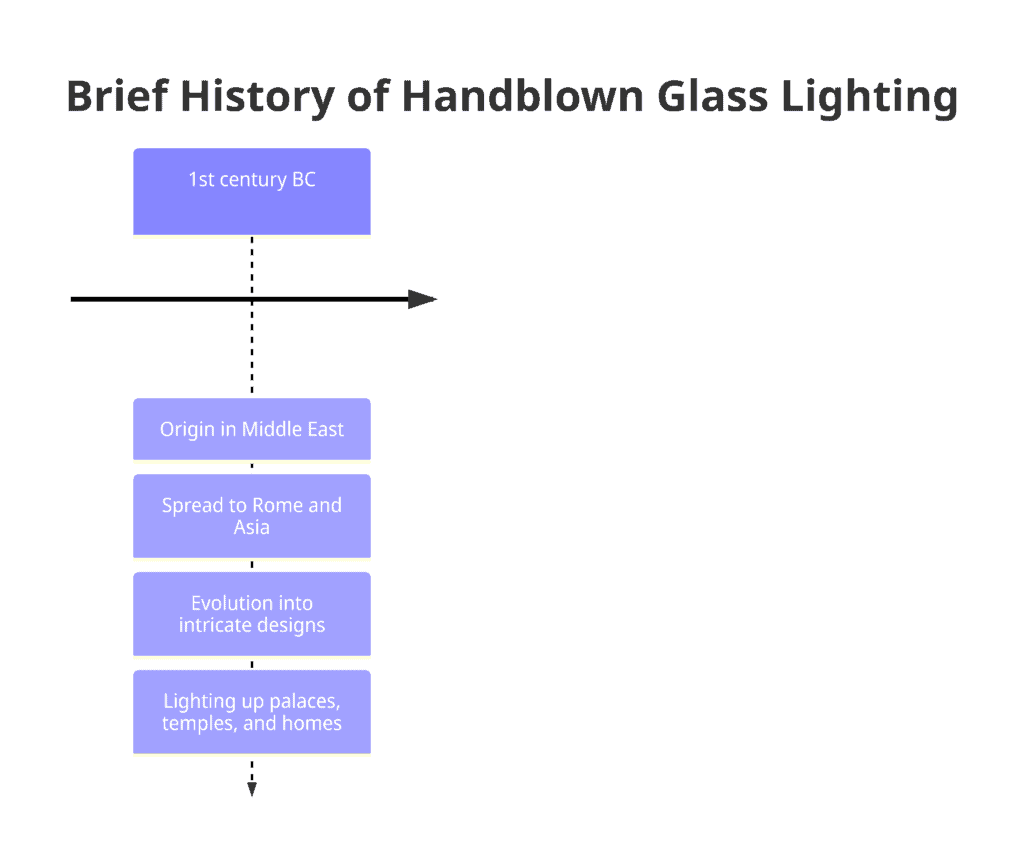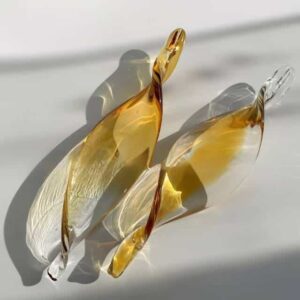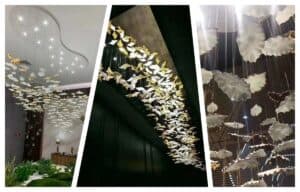The Ultimate Guide to Pricing Handblown Glass Lighting: Understanding Value & Craftsmanship
Published on 2023年 9月 2日 by iartglass

Introduction
Handblown glass lighting is not just a mere decorative element; it’s an artifact, a testament to human creativity and precision.
Brief history of handblown glass lighting

Glassblowing is an ancient craft, dating back to around 1st century BC in regions now known as the Middle East. This mesmerizing art quickly spread across the globe, from the vibrant streets of Rome to the bustling markets of Asia. And with time, the humble beginnings of glass turned into intricate designs lighting up palaces, temples, and homes. The timeless elegance of handblown glass stands as a testament to this history.
The rise in popularity of artisanal craftsmanship
In an age dominated by mass production, there’s a renewed appreciation for the unique, the bespoke, and the handmade. Artisanal craftsmanship, especially in areas like handblown glass, offers an unmatched personal touch. Discovering the artistry involved in these creations makes them far more than just objects; they’re stories, they’re passions, they’re legacies.
What is Handblown Glass Lighting?
The sheer beauty of handblown glass lighting lies not just in its final form but in the journey it undertakes, from molten raw materials to stunning art pieces.
Definition and key characteristics
Handblown glass lighting refers to luminaires made by introducing a ‘gather’ of molten glass at the end of a blowpipe and molding it into desired shapes through air and tools. The key characteristics include:
- Uniqueness: No two handblown pieces are exactly alike.
- Texture: They often have varied textures, imperfections, and bubbles that add to their charm.
- Color Depth: Handblown glass exhibits depth and richness in color, often created by layering.
The process of hand blowing glass
The creation of a handblown glass piece is an art, a dance between the craftsman and the elements:
- Gathering: The first step involves collecting the molten glass on the blowpipe.
- Shaping: Using tools and their hands (protected by wet newspaper), artisans shape the gather.
- Inflating: By blowing air into the blowpipe, the artisan inflates the glass into a bubble.
- Molding: The inflated glass can then be molded into various shapes and designs.
- Annealing: The formed glass is slowly cooled in an annealing oven to relieve internal stresses.
Distinction from machine-made glass
While both forms of glass can be beautiful, there are clear distinctions:
| Handblown Glass | Machine-Made Glass |
|---|---|
| Unique with slight variations | Uniform and consistent |
| Richer depth of color and texture | Often clear and flawless |
| Crafted with personal touch | Produced in bulk |
| Often has bubbles and imperfections | Aimed at being bubble-free |
Factors Influencing the Cost of Handblown Glass Lighting
The price tags on handblown glass lighting aren’t just arbitrary numbers. Several factors culminate to define the cost, making each piece a unique investment.
Craftsmanship and time taken to produce each piece
Each handblown glass lighting fixture is a labor of love, demanding time, skill, and patience. The techniques employed are often passed down through generations, perfected over decades. As with any art form, the time and effort invested in creating the piece significantly affect its price. Unlike mass-produced items, the process of creating a single handblown piece can span days, if not weeks, depending on its complexity.
Quality and type of materials used
Not all glass is made equal. The purity of materials, the type of colorants, and even the gas used for blowing can vary in quality. Premium materials, which often result in clearer, more vibrant, and durable creations, can elevate the price. Exploring the differences between hand-blown and machine-made glass can provide deeper insights into the materials’ significance.
The intricacy and uniqueness of design
A simple spherical pendant light and a chandelier featuring dozens of handblown components will differ significantly in price. The complexity of the design, the number of parts, and the detailing required play a crucial role in determining the cost.
Brand reputation and artist’s renown
Just as with any luxury item, the brand and artist’s reputation can influence the price of handblown glass lighting. Well-established brands or artists, like Siga Art Glass, have built their reputation over years or even decades, ensuring quality, authenticity, and unique artistry, which is reflected in their pricing.
Comparing Handblown to Machine-Made Glass Lighting
When in the market for glass lighting, it’s essential to understand the differences between handblown and machine-made pieces, especially in terms of benefits and cost.
Benefits of handblown over machine-made
- Individuality: Each handblown piece is unique, offering individuality and character.
- Artistry: Handblown pieces often tell a story, reflecting the artist’s vision and emotions. This journey from fire to fascination is visible in every curve and hue.
- Customization: While machine-made designs often come in standardized shapes and colors, handblown glass offers customization, tailored to the buyer’s desires.
Price differences and what they reflect in terms of value
Machine-made glass, produced in bulk, often comes with a lower price tag. The economies of scale play a significant role here. However, the slightly higher price of handblown glass reflects its intrinsic value:
- Craftsmanship: As mentioned earlier, the hours of work and skill that go into each handblown piece justify the cost.
- Material Quality: Handblown glass often utilizes superior materials, ensuring longevity and better aesthetic appeal.
- Emotional Value: Owning a unique piece, knowing there’s no other like it in the world, adds a sense of exclusivity and emotional value.
Understanding the Value Proposition
In today’s world, where everything is evaluated in terms of its return
on investment, it’s essential to understand the value proposition of handblown glass lighting. Why invest in such pieces when there are cheaper alternatives available?
Longevity and durability of handblown glass
One of the standout features of handblown glass is its longevity. Crafted using time-tested techniques and superior materials, these pieces are built to last. Unlike mass-produced items that might show wear and tear quickly, handblown glass lighting retains its charm, often outliving its initial buyers and becoming cherished heirlooms. Moreover, with the right care and maintenance, these pieces can look as radiant as the day they were crafted.
The unmatched aesthetic appeal
There’s a certain magic in owning a piece of art, and that’s precisely what handblown glass lighting offers. The myriad of colors, the dance of light and shadow, and the tiny imperfections all come together to create an unmatched aesthetic appeal. These pieces don’t just illuminate spaces; they transform them, turning mundane corners into focal points of admiration.
Customization possibilities
Handblown glass lighting comes with the unique advantage of customization. Whether you desire a particular color to match your interiors or a specific shape to reflect your personality, artists can bring your vision to life. Such customization is nearly impossible with machine-made pieces. With handblown glass, your living space can truly mirror your essence.
Price Ranges and What to Expect
Handblown glass lighting, given its artisanal nature, spans a broad pricing spectrum. Let’s break down what you can anticipate at different price points:
Entry-level pricing: What you get
At the entry-level, you can expect simpler designs and smaller pieces, but that doesn’t mean compromising on quality. These are perfect for individuals looking to introduce handblown art into their spaces without a hefty investment. You might find beautiful pendants or smaller table lamps that still showcase the signature characteristics of handblown glass, such as unique patterns and textures.
Mid-range pricing: Best value for money?
The mid-range is where most buyers find the sweet spot. You get more intricate designs, larger pieces, and often, the option for customization. Pieces in this range are substantial enough to be conversation starters, reflecting a blend of craftsmanship and artistry. This segment can offer some of the best illuminating masterpieces that don’t break the bank.
Premium pricing: The epitome of luxury
At the premium end of the spectrum, you’re not just buying lighting; you’re investing in art. These are pieces crafted by renowned artists or brands like Siga Art Glass, often limited editions or one-of-a-kind creations. The designs are intricate, the materials are the finest, and the craftsmanship is unparalleled. They are statements of luxury, taste, and sophistication.
Tips for Buyers: Getting the Best Value for Your Money
Investing in handblown glass lighting is not just a financial decision, but also an aesthetic and emotional one. Ensure you’re making a well-informed choice with the following tips:
Questions to ask before making a purchase
- Who is the artist or brand behind the piece? Familiarize yourself with their work and reputation.
- How is the piece crafted? Understanding the techniques used can provide insight into its value.
- What materials were used? As mentioned before, the quality and type of materials significantly influence the product’s longevity and aesthetic.
- Is customization possible? If you have a specific vision in mind, can the artist or brand accommodate it?
- What’s the return or repair policy? While handblown glass is durable, it’s still glass and can be delicate.
Authenticity checks: Ensuring you’re getting genuine handblown glass
- Signature or Stamp: Many artists and brands, including Siga Art Glass, may have a signature or stamp on their pieces as a mark of authenticity.
- Imperfections: Genuine handblown glass will often have slight imperfections, like bubbles or variations in thickness, which are telltale signs of its authenticity. The intrigue of such imperfections often adds to its charm.
- Ask for Documentation: Some artists provide certificates of authenticity or a backstory of the piece’s creation.
Caring for your handblown glass lighting to ensure longevity
- Regular Dusting: Use a soft microfiber cloth to keep your piece looking pristine.
- Avoid Harsh Chemicals: When cleaning, opt for mild soap and lukewarm water.
- Handle with Care: While moving or changing bulbs, handle the piece gently to prevent scratches or damages.
- UV Protection: Prolonged exposure to direct sunlight might fade the colors. Consider placing the lighting in a location where it won’t be subjected to constant sunlight.
The Role of Brands in Determining Price
Brand names in the world of handblown glass lighting aren’t just about prestige; they’re often a guarantee of quality, authenticity, and masterful craftsmanship.
Why trusted brands like Siga Art Glass stand out
Siga Art Glass, with its rich legacy and unwavering commitment to excellence, is more than just a name. Here’s what stands behind such renowned brands:
- Experience and Expertise: Years, often decades, of experience ensures a mastery over the craft. This translates to pieces that aren’t just beautiful but are also crafted to perfection.
- Consistent Quality: Trusted brands have quality checks in place, ensuring that every piece that leaves their studio meets a particular standard.
- Authenticity Guarantee: With counterfeit and machine-made products flooding the market, brands provide an assurance of genuine handblown glass.
The promise of quality and authenticity
Renowned brands in the handblown glass industry are built on a foundation of trust. This trust is a culmination of consistent quality, unmatched craftsmanship, and a genuine love for the art. When you invest in a piece from a trusted brand, you’re not just buying a lighting fixture; you’re becoming a part of a story, a tradition, and a legacy that promises to shine bright for years to come.
Conclusion
In a world inundated with mass-produced items and fleeting trends, handblown glass lighting stands as a testament to human artistry, perseverance, and the relentless pursuit of beauty.
Each piece, with its unique charm and story, offers more than just illumination; it brings warmth, character, and a touch of magic to spaces. As with any art form, understanding its value, history, and the craftsmanship behind it can enhance the appreciation manifold. Whether you’re a collector, a homeowner looking to elevate your interiors, or someone with a penchant for the unique, handblown glass lighting promises to be a radiant addition to your life.
References and Additional Reading
- Differences Between Hand-Blown and Machine-Made Glass
- Unlocking the Art of Hand-Blown Glass: A Buyer’s Guide to Lamp Parts Selection
- From Fire to Fascination: The Illuminating Journey of Hand-Blown Glass Lamps
- Mastering the Luminescence: Ultimate Care Guide for Hand-Blown Glass Lamps
- The Timeless Elegance of Hand-Blown Glass: From Ancient Craft to Modern Masterpieces at Siga Art Glass
May your journey through the mesmerizing world of handblown glass lighting be filled with wonder, illumination, and an ever-deepening appreciation for the art that lights up our lives in more ways than one.




